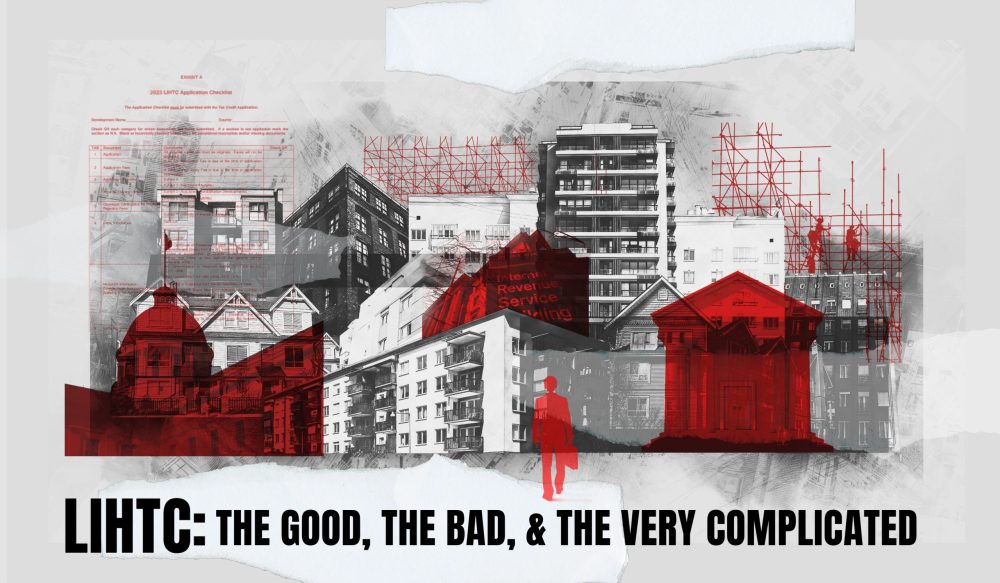This article is part of the Under the Lens series
LIHTC: The Good, the Bad, and the Very Complicated
The Low-Income Housing Tax Credit (LIHTC) is a ubiquitous presence in the affordable housing field. The program helps to finance, by some counts, around 90 percent of affordable rental projects in the U.S., and it provides the largest chunk of funding for the deals in which it is involved.
Most housing advocates know these things about LIHTC:
- It’s extremely complicated.
- It’s the only housing finance program with ongoing, active bipartisan support, and it produces tens of thousands of units per year.
- It benefits big financial institutions to the tune of billions of dollars.
- And it’s hard to imagine the current landscape of affordable housing development without it.
How did we get here?
The History of LIHTC
By the 1960s, the quality of once-thriving public housing was in steep decline, due in part to decades of intentional underinvestment from the federal government. Instead of fixing the underinvestment, successive administrations tried various ways to encourage a shift to private provision of affordable housing. The Tax Reform Act of 1969 introduced tax breaks that were specific to affordable housing, but were also subject to a lot of fraud. In the mid-1970s, direct subsidies for construction and rehab of affordable rentals were passed as part of the Section 8 program. When the Reagan administration took office in 1981 with a philosophy of trickle-down economics and reduced federal spending to help the poor, it severely cut funding for affordable housing programs, including the Section 8 construction subsidies.
The administration claimed there was no longer a shortage of rental housing that necessitated direct construction subsidies. It did, however, make tax rule changes that allowed wealthy individuals to write off losses from “passive activities,” which included owning rental properties. This, the administration believed, would encourage investors to develop affordable rental properties.
But the plan didn’t work: without construction subsidies, investors purchased cheap housing rather than building it, avoided paying any taxes, and neglected their properties to get bigger write-offs. Congress regrouped in the mid-1980s to try to fix the tax code, including removing this provision.
Not wanting incentives to build affordable housing to be lost in the process, a coalition of affordable housing organizations led by the National Low Income Housing Coalition (NLIHC), and including the intermediaries Enterprise Foundation (now Enterprise Community Partners) and the Local Initiatives Support Corporation, helped craft the Low-Income Housing Tax Credit program. According to one review of the Congressional debate at the time, LIHTC was seen by members of Congress as something that would be used by wealthy individuals to get tax breaks by investing in affordable housing. According to that review, the central roles that corporate investors and nonprofit developers quickly came to play in using the LIHTC program were not envisioned by elected officials when the program was first created.
The tax credit was not universally supported in the affordable housing field at the time. Barry Zigas, then–president of NLIHC, testified to Congress that direct funding would be more efficient, even as he proposed and supported the tax credit as a critical way to maintain some support for new affordable housing construction in the face of the Reagan administraion’s attacks. LIHTC passed in the Tax Reform Act of 1986, and without alternatives to work with, the affordable housing field leaned into it. Some affordable housing leaders developed a process whereby nonprofit developers would apply for the credits and then sell them to corporations, typically through intermediaries.
The corporations benefit in two, sometimes three, ways. They get the direct tax break, and also are allowed to write off the depreciation of the property (the “passive activity” provision that was no longer broadly available outside of this program). An appealing bonus on top of these tax breaks was improved CRA ratings for those investors that were also banks subject to the Community Reinvestment Act. And so financial institutions quickly became major investors in LIHTC projects.
By the time the tax credit first came up for congressional renewal in 1989, there was enough political support from these new corporate investors and the affordable housing community to get it renewed. The program was made permanent in 1993.
As funding for other affordable housing programs continued to decline in the 1990s and 2000s, LIHTC became more and more central to affordable housing delivery. And as it became clear to for-profit developers that LIHTC developments were low-risk investments, they started to actively seek out tax credit deals themselves, and now conduct a substantial percentage of LIHTC projects. (It’s hard to know exactly how many.) To date, LIHTC has helped to produce about 3 million units, and costs taxpayers approximately $9 billion a year.
All Things to All Housers?
Because of its omnipresence in the housing world, LIHTC has been called upon to do many things. Because the priorities for awarding the tax credits on the state level can be changed by state housing finance agencies relatively easily, they are a frequent target of advocates seeking to achieve goals like introducing more affordable housing in higher-income areas, encouraging green building, or providing more residential services. As other types of funding for affordable housing have waned, LIHTC has been called upon to handle rehab and supportive housing projects, and even, under the Rental Assistance Demonstration program, public housing redevelopment projects.
While many housing advocates celebrate that LIHTC represents an enduring public-private partnership, others remain critical of routing affordable housing support circuitously through tax breaks to major corporations. Along with philosophical objections, complaints about lack of clear record keeping, and concerns about the inefficiency of routing the funds through so many layers, lawyers, and other players, another source of misgiving is the fact that this arrangement makes the availability of funding dependent on corporate profits and tax rates. When corporate profits took a hit in the Great Recession, the demand for the tax credits temporarily tanked. When the corporate tax rate was lowered in 2017, which shrunk the tax liabilities corporations wanted to offset, the price that they were willing to pay for the tax credits dropped and has stayed down. This is one of the reasons why the number of different sources of funding that a LIHTC developer has to secure for its “capital stack” in addition to the credits has increased.
LIHTC is the one housing construction program that doesn’t have to fight for its very existence and appropriation almost every budget cycle. That means that for the past couple of decades the affordable housing world has encouraged its members not to air any dirty laundry about LIHTC, so as not to kill the golden goose. Supporters have put together a reform agenda of ways to make the program stronger and more widely available. There has been critique from fair housers about the lack of construction in higher-income areas, and tenant advocates have started to speak up about the program’s lack of tenant protections. But criticism beyond accepted reform goals from within the affordable housing development side of the sector has been muted. Off-the-record conversations indicate that substantial numbers of housers fear serious professional backlash if they openly question whether this is really the best way to deliver affordable housing finance.
The Good, the Bad, the Very Complicated
While Shelterforce regularly covers topics related to the functioning of the LIHTC program, we decided it was time to do an Under the Lens series on LIHTC from a few different angles—what residents might want to know about the program, who enforces its rules, the current state of efforts to reform it, and some of the effects of its being so dominant in the sector. While we’re not going to offer an overarching judgment of the tax credit program, we hope to provide enough information to help those unfamiliar with LIHTC to understand it and engage with it. We hope also to give voice to some of the experiences and observations of those who do use it, or try to. As always, this is not the end of the conversation—send us your ideas and feedback for our continued exploration of this this pivotal program, and alternatives to it.
[Correction: This article has been updated to reflect the role of the National Low Income Housing Coalition in advocating for the tax credit.]
|
Now through Dec. 31, all donations to Shelterforce will be matched. Double the impact of your donation by supporting our work today. |






LIHTC leaves no room or exceptions for very low income non elderly disabled people. Our only option is CHA which has a 25 year wait-list here in Chicago. This is extremely unfair to those of us whose only income is SSDI, because we don’t make any where near $32,000 – $42,000 a year. So we’re very close to homelessness.
Yay! This is overdue. We need to build the next system of financing permanent affordable housing while salvaging this one. It goesway beyond this simple sentence…
Thanks for starting this conversation. I’m an ex-affordable housing professional who left the sector because I didn’t want to participate in LIHTC projects. Whenever I raised “philosophical” questions about the program, I was the lone voice in the room and powerless to make any difference. My concerns are first and foremost the financial inefficiency of government subsidies delivered through LIHTCs. With Big Finance behind the current system, I find it difficult to imagine how to reform it.
Thanks for this article. I think it would be useful to use this review to look at the current post pandemic challenges in LIHTC development, management and ownership.
Thanks Chris. I can come up with a long list of post-pandemic LIHTC challenges, but am curious which ones in particular stick out to you?
Does anyone know if a not-yet-built housing cooperative project might qualify for LIHTC?
My understanding is that LIHTC is strictly a rental program. You’d have to be planning to transition it to a cooperative after at least 15 years. Also, I’m not a lawyer or an expert, so check with one.
I currenty live in an LIHTC & have been priced out. Ladt year my rent went up $140 per mo & this year an additional $260 mo. My rent is now 65% of my total income. There are no HCV’s available & tjey aren’t adding to the waiting list. There has to be a better way, or at the very least a cap on the rent for low income seniors & disabled of any age. I will be living in my car in May…
Hi Anita, thank you for being a reader. We are sorry to hear about the possibility of losing your housing. Shelterforce is a nonprofit media organization and publication dedicated to reporting on affordable housing, housing justice, and community development. While we cannot offer aid directly, our team and a few valuable contributors have put together a list of resources that we hope you may be able to use: https://shelterforce.org/need-help-finding-housing/
Hi all, thanks for the interesting reading and discussion. You may be interested in a reflection on LIHTC from a community development perspective, at https://wbcdc.org/reflections-on-a-half-century-of-housing-development-in-cedar-riverside/